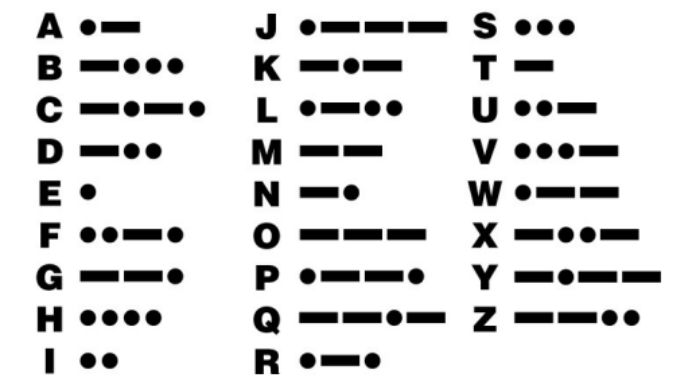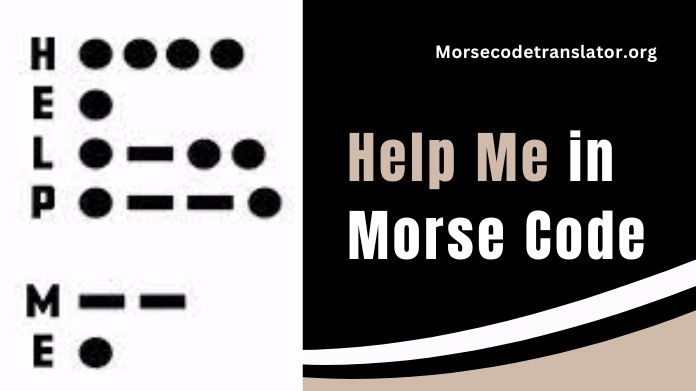Morse Code, an ingenious communication system utilizing dots and dashes, is a testament to the historical significance of coded messages.
This guide focuses on a specific and urgent plea— “Help Me in Morse Code.” Embarking on this journey not only unravels the intricacies of Morse Code but also connects us to a timeless heritage where this system has played a pivotal role in signaling assistance.
The rhythmic arrangement of dots and dashes, synonymous with Morse Code, has served as a universal language in moments of crisis for centuries.
As we delve into articulating the phrase “Help Me in Morse Code”, we are not merely learning a set of symbols but decoding a timeless cry for aid that echoes through history.
Join us in this exploration of Morse Code Translator, where each sequence of dots and dashes carries a profound significance. Through understanding how to convey the plea “Help Me” in this symbolic language, we unravel the layers of Morse Code’s enduring legacy.
This legacy transcends time and technology, showcasing the enduring power of human ingenuity in communication.
How to Use Morse Code?

Morse code is a method of transmitting textual information using sequences of dots (.) and dashes (-) to represent letters, numbers, and symbols.
It was developed by Samuel Morse and Alfred Vail in the early 1830s and was widely used for long-distance communication in telegraphy and radio transmission before the advent of more advanced communication technologies.
Basics:
- Dots are short signals; dashes are long signals.
- Each letter and number has a unique Morse Code representation.
Transmitting Messages:
- Use light, sound, or visual/auditory signals.
- Practice with apps, online resources, or flashcards.
Example:
- “HELLO” is …. . .-.. .-.. — in Morse Code.
You can quickly start using Morse Code for communication by grasping these basics.
How to Write Help Me in Morse Code?

You’re being held captive and made to compose a fictitious letter that explains your permanent departure. You can’t just write “Help me, I’m being kidnapped” in the letter knowing that your abductor will read it.
Instead, you choose to be stealthy and enlist assistance by encoding a message in Morse code beneath your signature. It’s still preferable to XOXO, even though it requires the letter’s recipient to understand or be familiar with Morse code.
Help Me in Morse Code is:
H • • • •
E •
L • ─ • •
P • ─ ─ •
M ─ ─
E •
When laid out on a single line, “help me in Morse code” will look like this!
• • • • • • ─ • • • ─ ─ • / ─ ─ •
How to Say Help Me in Morse Code?
Speaking in Morse code is much more straightforward than you might think. The history of Morse code is mostly an audible one, and, as such, it is simple to mimic vocally.
Dots are pronounced “di,” while dashes are pronounced “dah.”
To say “help me“ in Morse code, repeat the following:
di-di-di-di di di-dah-di-di di-dah-dah-di / dah-dah-di
“Help Me” in Other Languages
A beautiful feature of Morse code is that it is Universal. This means that we can use it to communicate in various languages.
Below are a few “help me” examples in Morse code using other languages!
Spanish: ayúdame
•─ ─•─ ─ ••─ ─•• •─ ─ ─ •
French: aide-moi
•─ •• ─ •• • ─ ••••─ ─ ─ ─ ─ ─ ••
German: hilf mir
•••• •• •─•• ••─• / ─ ─ •• •─•
Russian: Помоги мне
•─ ─• ─ ─ ─ ─ ─ ─ ─ ─ ─ ─• • • / ─ ─ ─• •
Italian: aiutami
•─ •• ••─ ─ •─ ─ ─ ••
Wrapping Up!
In wrapping up our Morse Code journey to write “Help Me,” we’ve uncovered the secret language of dots and dashes that makes urgent communication timeless.
Morse Code, with its straightforward signals, goes beyond being just a code—it’s a link to a history where quick and clear messages matter.
In this simple guide, we’ve learned that “Help Me” in Morse Code is a sequence of dots and dashes, connecting us to a past where communication was about precision and immediacy.
So, whether you’re exploring for curiosity or emergency preparedness, decoding “Help Me in Morse Code” brings a touch of history to your fingertips.
